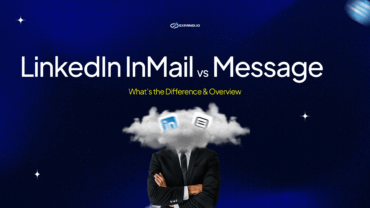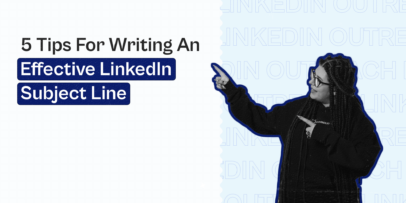Lead Generation Processes, SOPs, and Frameworks From The World’s Best Companies
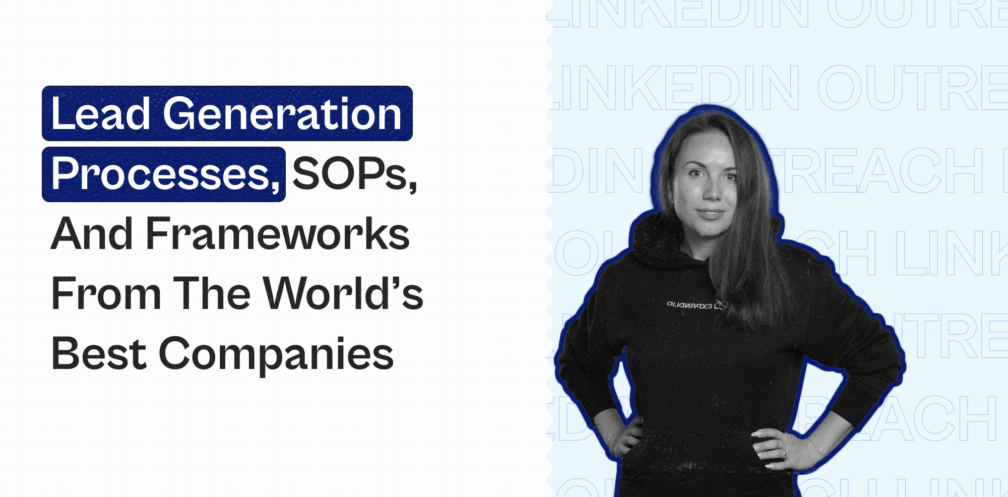
Designing an effective lead generation process is a must-have step in any successful sales strategy.
If you want to close deals and convert leads, there are a few things you have to take care of first, including:
- Identifying your target audience
- Sifting through it to find high-quality leads
- Nurturing those leads and gradually pushing them toward the bottom of your sales funnel
And yet, creating a lead generation process from scratch is challenging.
Fortunately, you can always turn to the world’s most successful companies for some much-needed inspiration.
And that’s exactly what we’ll provide you with in this article — key insights into all the tricks, hacks, and processes that brought these enterprises straight to the top.
Here’s what we’ll cover in detail:
And here’s a summary of our findings:
TL;DR
- PayPal generates leads through referral marketing. Paypal also offers a versatile platform with a wide range of uses.
- Netflix focuses on introducing new features that enhance its product. Netflix also embraces interactive experiences, FOMO, and LinkedIn.
- Salesforce generates leads by creating a rich customer community. Salesforce has also invested heavily in free resources and LinkedIn events.
- Adobe generates leads with content marketing and LinkedIn. Adobe also uses special offers, free trials, and discounts to draw customers in.
- Zoom used TikTok to grow quickly and has invested heavily in events. Zoom is also very responsive on LinkedIn.
- HubSpot creates a lot of content marketing and encourages users to list specific HubSpot skills in their LinkedIn profiles.
- Slack uses word-of-mouth marketing. Slack also uses its integrations to its advantage.
Attributes of a successful lead generation process
Although each company listed here has a different lead generation process unique to its industry and target audience, there are some things they all have in common.
These shared attributes are the essential elements of a highly-successful lead generation strategy.
These attributes are:
- “Highly targeted” — There’s no point in pitching to anyone you can get a hold of, as attracting the wrong crowd is a major waste of your time and money. That’s why it’s pivotal to get your product or service in front of your target audience — i.e., the people and companies who actually fit into your buyer persona and Ideal Customer Profile (ICP). They’ll be the most likely to convert.
- “Multi-channel” — A multi-channel approach helps you reach as many potential customers as possible. You can’t expect all your leads to dwell in the same place and consume just one type of content. So, covering many different areas will help you find more qualified leads than sticking to one marketing channel alone.
- “LinkedIn-based” — LinkedIn data shows that 4 out of 5 LinkedIn members are business decision-makers — precisely the kind of people you want to reach. Additionally, 70% of B2B social media leads come from LinkedIn. So it’s not a marketing channel you can ignore.
- “Hyper-personalized” — A staggering 80% of consumers say they’re much more likely to buy from a company that provides them with a customized experience, and it’s no wonder why — no one appreciates being treated like another faceless number.
Just think of how you feel when you get a generic and blatantly salesy LinkedIn message versus when you get a highly-personalized one that strikes a chord with you. Which one’s going to stick with you? Keep the answer to that question in mind when reaching out to potential customers.
- “Engaging and compelling” — You have to be interesting and have something that sets you apart from the competition for your leads to seriously consider you as an option. For example, to stand out from the crowd, you can include the following in your lead generation marketing:
- Your brand’s storyRegular shout-outs to loyal customersInsights into your company’s core values
- “A focus on both nurturing and attracting leads” — Finding high-quality leads is just the first step of the process because you’ll have to give them a good reason to stick around long enough to finally convert. Things that can get you a long way include:
- Regular follow-upsMaking special offers and discountsProviding them with valuable content and resourcesAsking for feedback on their experiences with your brand
Why companies struggle to build such a process
As we’ve mentioned, there are quite a few things you have to think about when devising your lead generation strategy.
Making all those elements work together like a well-oiled machine isn’t exactly a stroll in the park. In fact, 61% of marketers feel lead generation is their biggest challenge.
Moreover, lead generation is costly: 53% of marketers say at least half of their budget is allocated to lead generation alone.
And it’s no wonder things are more difficult today than they were several years ago — the market is shifting faster than ever before, making it tougher to keep up with all the new trends.
The COVID-19 pandemic also introduced many new changes to every segment of everyday life, and sales and marketing processes are no exception.
Today, almost everything has migrated online, meaning there have never been as many channels for searching and reaching potential customers. As great as this is, it can be more than a little overwhelming.
It’s no wonder many companies stubbornly persist in using the same processes and frameworks for years on end — even though a lack of innovation puts them at a high risk of quickly becoming obsolete.
This means that you’ll have to adapt to all the challenges of contemporary sales and find a way to make the most of all the new opportunities if you expect to succeed.
However, it’s impossible to tackle all the possibilities simultaneously. Not to mention you’d end up breaking the bank in a blink of an eye.
So, what you have to do is determine which lead generation methods are suitable for you. As a result, you’ll create a lead generation campaign that will yield the results you want for your business.
Since testing and trying all those possibilities takes time and money, many marketing and sales teams feel quite disheartened when faced with designing a good lead generation strategy for their companies.
That’s precisely why getting insight into what all the bigshots are doing — and how they’re making it work — can help you build a bulletproof lead generation process much faster.
Analyzing the lead generation processes of leading companies (+ takeaways)
And now, the juicy part!
We’ll dissect the lead generation processes of seven leading companies and highlight the key takeaways from each.
That way, you’ll know what to focus on when building your winning lead generation strategy.
PayPal
PayPal, a world-known solution for everyone who needs to make or receive payments, has several tricks up its sleeve when it comes to lead generation.
Firstly, PayPal is big on referral programs. In fact, one of the main secrets to PayPal’s rapid growth and success was its referral lead generation marketing.
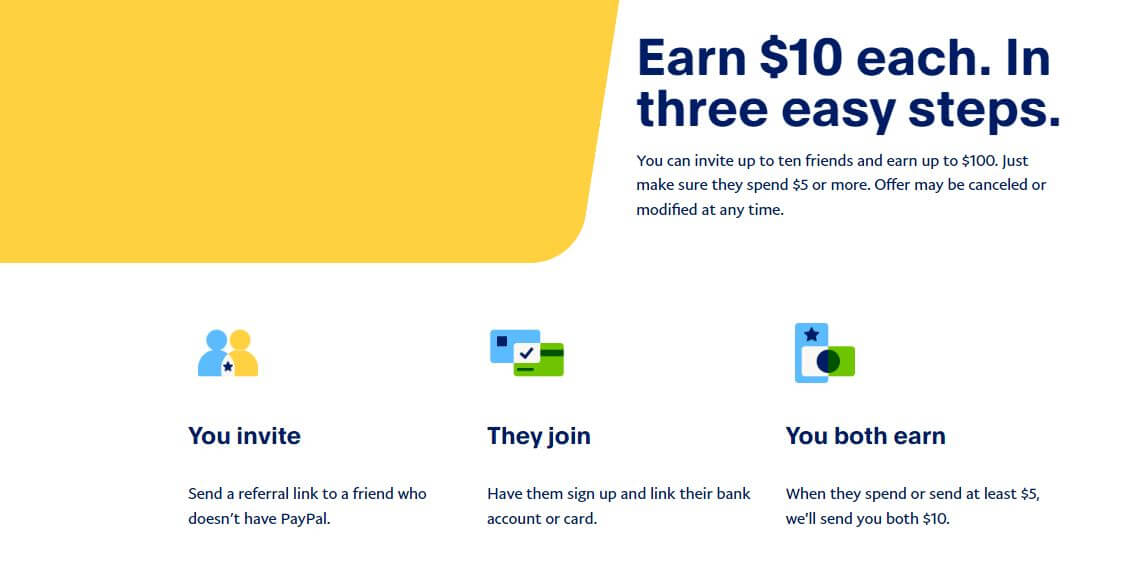
Users who invite other people to PayPal will get $10 when their invitees spend or send at least $5.
This provided an excellent incentive for people to share their positive experiences with PayPal and recommend it to their friends, family, and business associates.
Moreover, PayPal has a special offer for users who sign up on its mobile app: they’ll receive $5 for downloading the app and registering their account.
These methods combined delivered terrific results for one simple reason — people love getting free stuff and all kinds of rewards. It’s human nature, and PayPal knows that.
One another lead generation strategy that relies on happy customers is sharing social proof through success stories and case studies. These do an excellent job of showcasing just how useful PayPal can be for users in versatile industries and businesses of various types and sizes.
Finally, PayPal scores by enabling flexible payment options, such as the possibility to buy now and pay later or allowing customers to pay for their purchases in four interest-free payments.
Offering more flexibility draws in more potential customers who are sick and tired of being stuck with rigid payment solutions.
Takeaways from PayPal’s lead generation approach:
- PayPal focuses on its happy and successful customers and relies on them to spread the word about its product.
- Using referral programs and rewarding users for downloading its app makes many users become brand advocates.
- Introducing more flexibility in features and use cases makes any product more attractive to a much wider group of prospective customers.
- Potential customers love hearing about a product from people who’ve already had the chance to use it. So, sharing social proof (e.g., success stories and shoutouts to customers who’ve achieved excellent results thanks to your products) supercharges any lead generation campaign.
Netflix
Netflix is a streaming platform that revolutionized how we experience television and movies.
For its lead generation strategy, Netflix relies on being a leader in its space.
Every now and then, Netflix introduces new features that refresh its offering and attract different types of high-quality leads. For example, Netflix has recently announced its first-ever live-streamed show, potentially opening the door for regular live events (e.g., sports, reality TV, etc.).
That way, Netflix will widen its target audience, as it will attract a whole range of potential customers who consume this kind of live content, which was, up until now, reserved for traditional broadcasters only.
In addition, Netflix tends to gamify its content by releasing single and multiplayer games. Providing interactive experiences appeals to a young target audience.
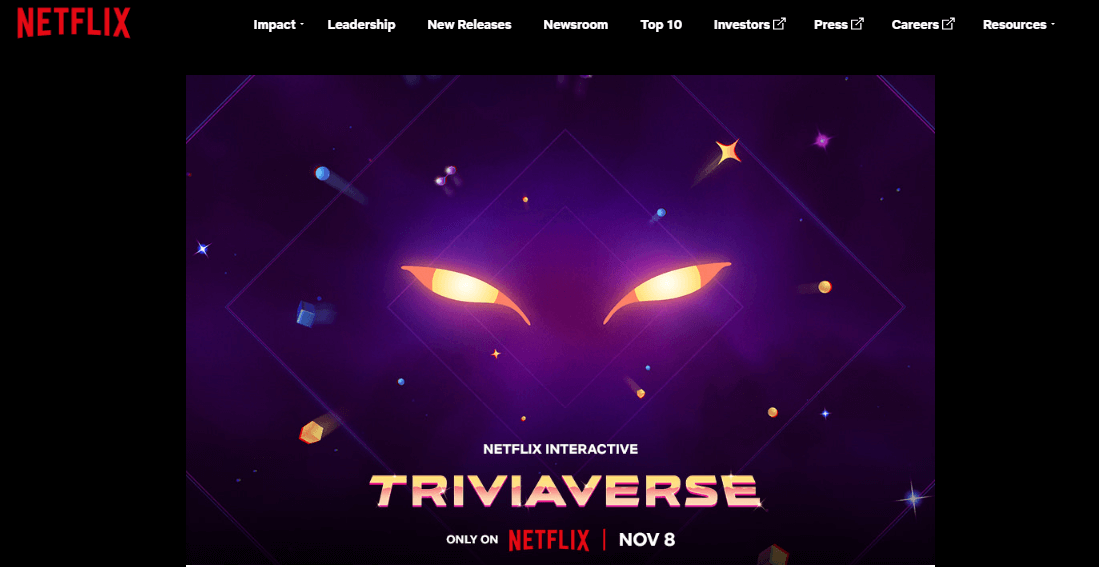
Moreover, Netflix makes the most of the Fear of Missing Out (FOMO) by regularly producing its own films and shows and making them available on its platform alone. These works are often an excellent incentive for Sales-Qualified Leads (SQLs) to opt for Netflix rather than another streaming service.
Netflix’s marketing and sales teams don’t stop there, though. They’re well aware of the importance of building a steady social media presence for lead generation, so that’s exactly what they’ve done.
Netflix has very active Twitter, Instagram, and LinkedIn accounts.
While its other social media profiles maintain a casual and entertaining tone, Netflix uses LinkedIn to share relevant announcements, teaser videos, and posts, as well as long-form content like articles. In addition, it does not shy away from using LinkedIn ads to get its content in front of as many potential customers as possible.
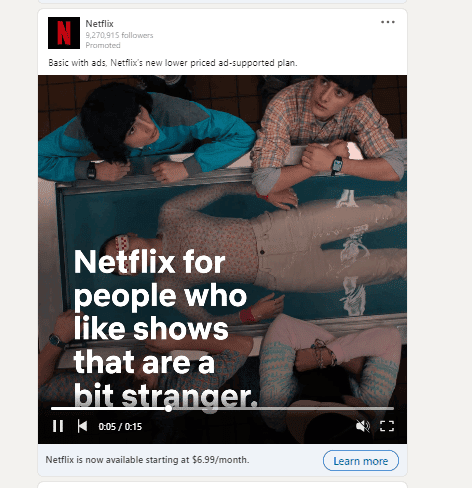
Takeaways from Netflix’s lead generation approach:
- Netflix succeeded in establishing itself as an industry leader through constant innovation and experimentation with new features. This makes Netflix a compelling option for younger generations in particular. However, its numerous functions and rich offering of movies and TV shows enable it to reach older user groups as well.
- Being bold in introducing new options and continuously expanding your standard offering will make your solution appealing to a much wider target audience.
- Netflix’s marketing and sales teams ensure that the platform has a very active presence on social media. Netflix takes a special approach to LinkedIn, as they know how important it is for effective lead generation.
LinkedIn as a lead generation strategy for Netflix
LinkedIn posts of all kinds are an excellent lead generation tactic, as companies that publish content on LinkedIn at least weekly see twice as much engagement compared to those that don’t post as regularly.
Moreover, the people who engage with your content are more likely to be SQLs because they’ve already shown interest in your offering.
So, having the option to scrape LinkedIn post likers and commenters gives you untapped access to an enormous pool of potential customers.
For example, with a lead generation tool like Expandi, you can scrape posts in a few simple steps.
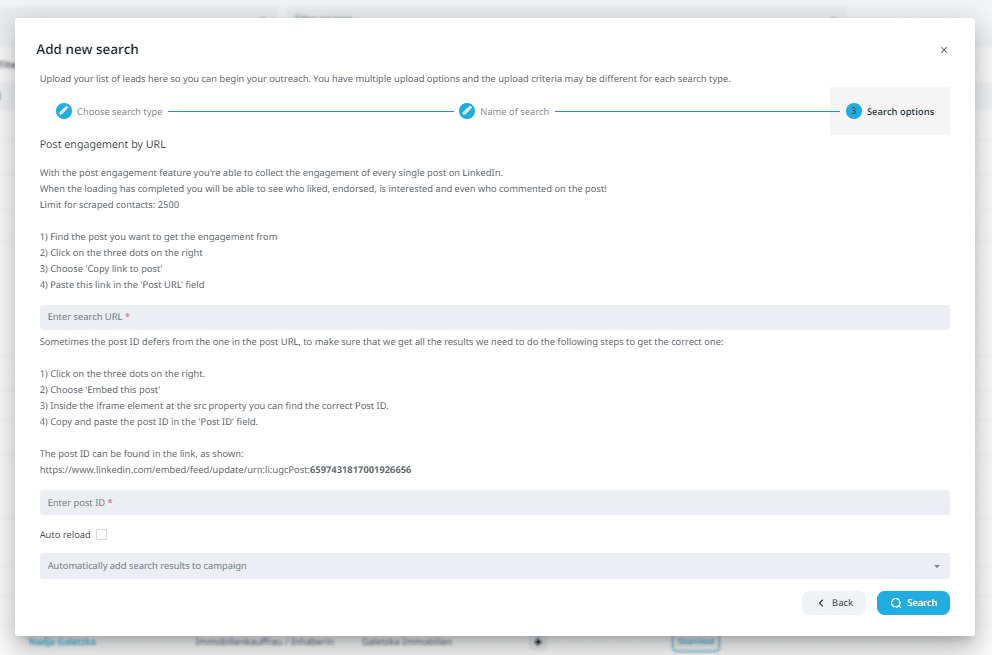
Curious? Sign up for a free 7-day trial with Expandi and discover how it can supercharge your lead generation process.
Salesforce.com
If anyone knows how to design and conduct an effective lead generation strategy, it’s Salesforce.
This platform is focused on Customer Relationship Management (CRM) and sales and marketing, so it’s only natural it should excel in lead generation and outreach. If it didn’t, it would speak volumes about the quality of its services.
Salesforce starts by leveraging its customer community to attract high-quality leads.
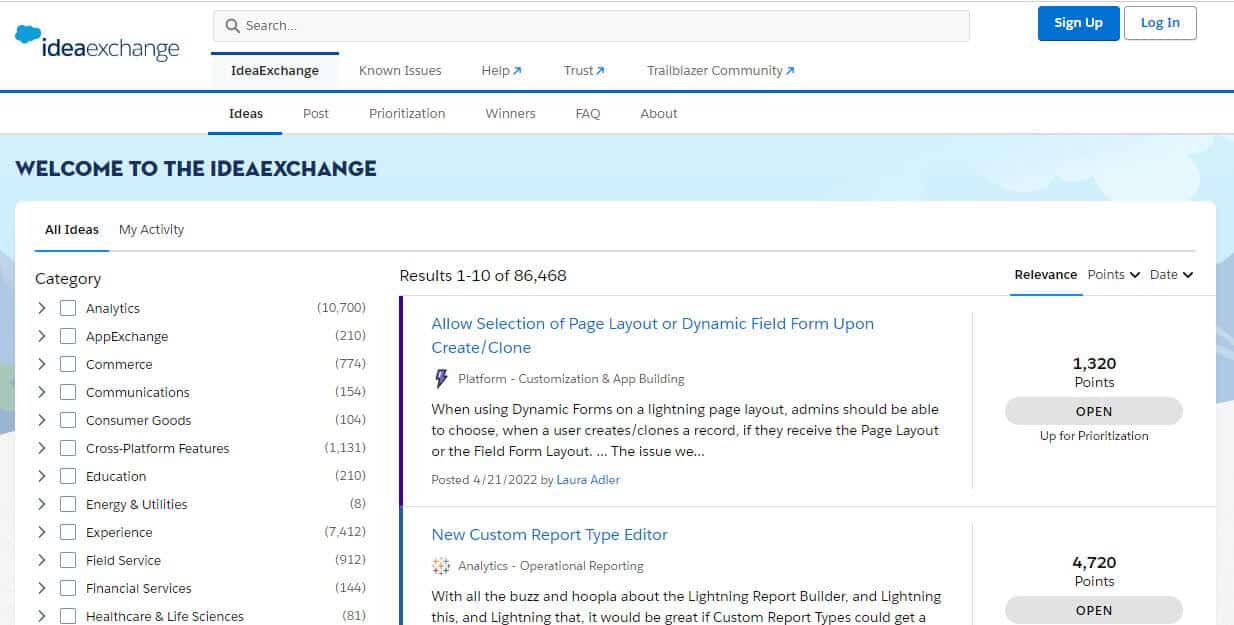
By providing existing and potential customers with spaces for Q&As and the exchanging of ideas, Salesforce achieves two things:
- It shows that its users’ feedback and needs matter
- It creates a tight sense of community among users. This is especially appealing to potential customers who’d like to know that they can rely on an entire chain of people for support.
Furthermore, Salesforce is huge on all kinds of free resources, from demos to videos, guides, eBooks, and even free training for specific user categories (like veterans).
However, you must fill out a form to gain access to these resources. That way, Salesforce’s sales team can collect contact information from SQLs and follow up with them.
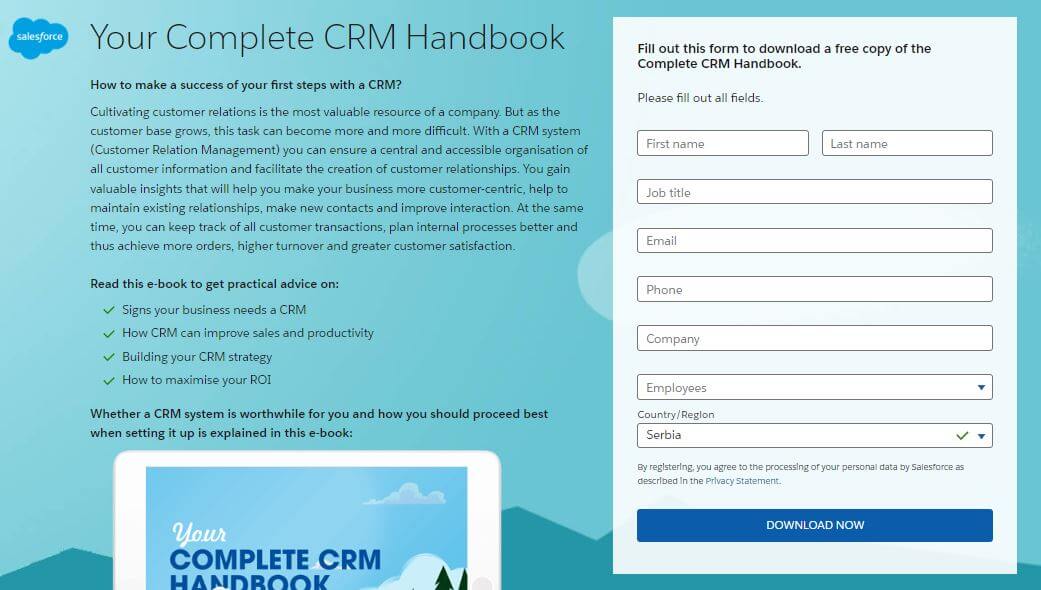
Salesforce provides an excellent example of using lead generation forms in the perfect way: people will be much more willing to leave their contact and company info in exchange for a free and valuable resource.
Finally, Salesforce is yet another leading company that uses LinkedIn to further its lead generation process.
Salesforce’s team regularly posts important updates on everything they do on LinkedIn, including:
- Announcing new features
- Promoting training courses
- Showcasing their team spirit and sense of community through participation in various fundraisers and charity events
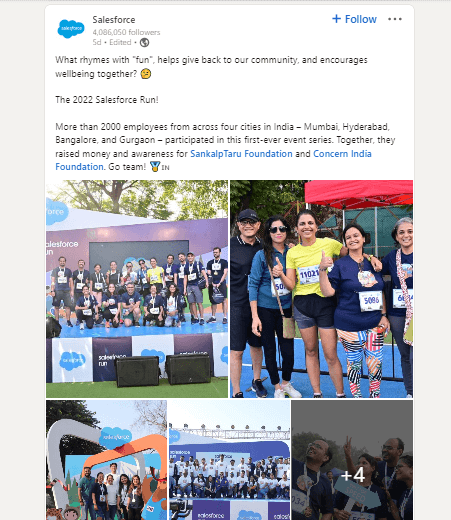
Salesforce also doesn’t miss out on another vital LinkedIn feature — LinkedIn events.
In addition to promoting in-person events on LinkedIn and enabling interested users to RSVP directly on the platform, Salesforce regularly organizes virtual LinkedIn events.
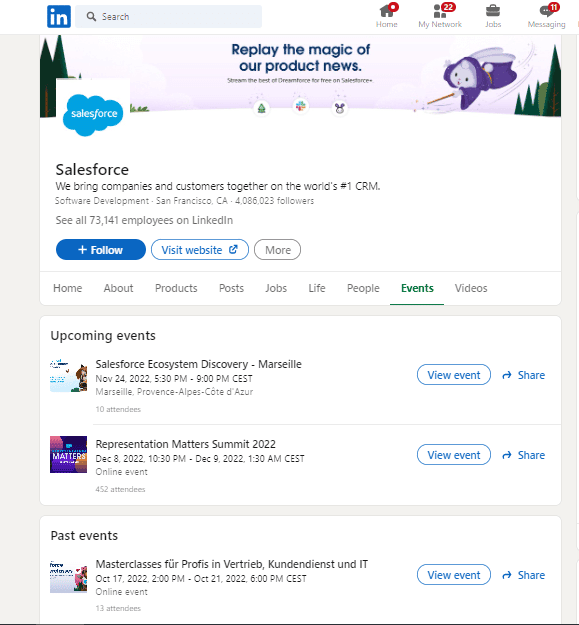
Takeaways from Salesforce.com’s lead generation approach:
- Clever placement of lead magnets and lead generation forms is one of Salesforce’s fortes when it comes to its lead generation process.
- Creating a strong sense of community among users is a major plus. It encourages potential customers to opt for Salesforce because they’ll get more than just a product — they’ll become part of a big, happy, Salesforce family.
- Offering free resources is always an excellent lead generation strategy, as people find freebies hard to resist.
- Organizing masterclasses, webinars, and virtual events regularly also helps Salesforce establish itself as an industry leader with all the necessary tools and know-how.
LinkedIn as a lead generation strategy for Salesforce.com
LinkedIn events are more than a way to attract potential customers and showcase your expertise. Just like LinkedIn posts, events provide a rich base of potential leads.
Namely, the people attending relevant events are undoubtedly interested in what you offer. So, events are one lead generation avenue you mustn’t overlook.
Learning who your event attendees are and reaching out to them with a highly-personalized message makes for a great lead generation strategy.
Helpfully, Expandi enables you to scrape event attendee lists and include them in automated lead generation and outreach campaigns in just a few clicks.
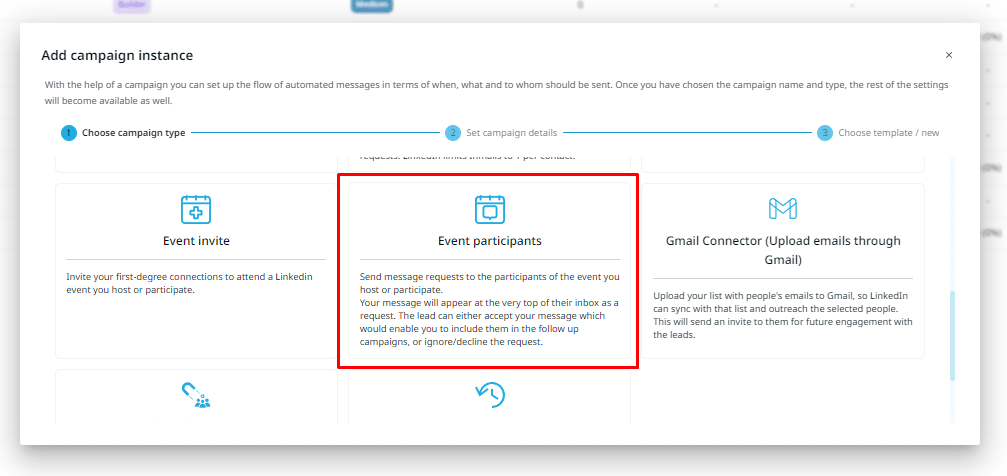
Adobe
Adobe has a suite of products that have become essential for all kinds of creators, from photographers to marketers and everyone in between.
As such, Adobe relies heavily on content marketing for its lead generation.
Comprehensive blog posts on various topics can score with different target audiences, as they’re both educational and fun to read.
Adobe is also big on video content — short teaser videos combined with more detailed tutorials help Adobe showcase what users can achieve with different Adobe products.
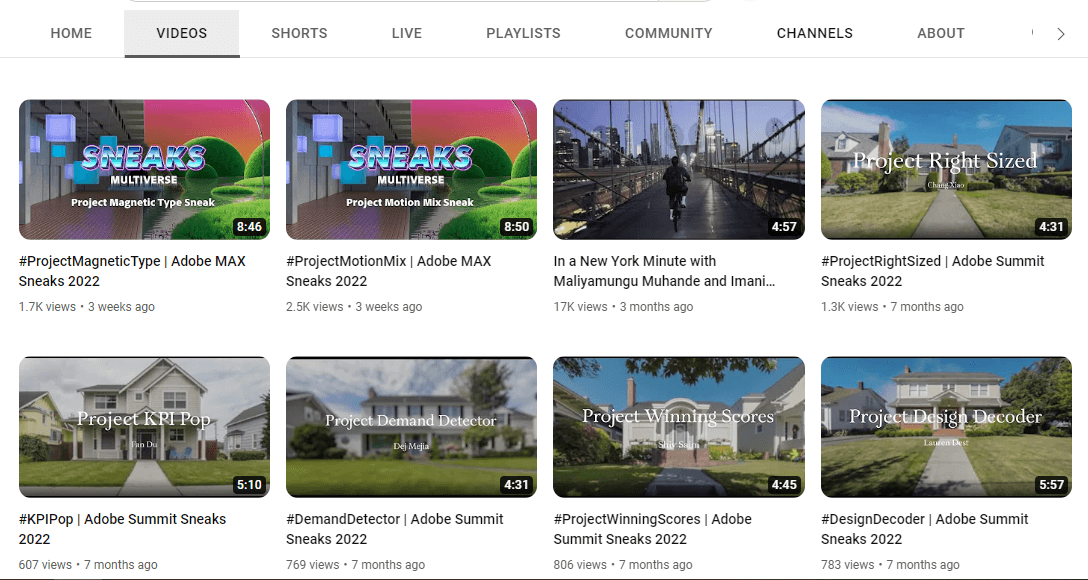
In addition, Adobe makes the most of a common human trait: our love for free and discounted stuff. That’s why it offers free trials of its products and releases special offers and discounts.
For example, students and teachers can access Adobe Creative Cloud for a lower price year-round, sales and marketing teams can get a bulk discount, and there are special Black Friday prices.
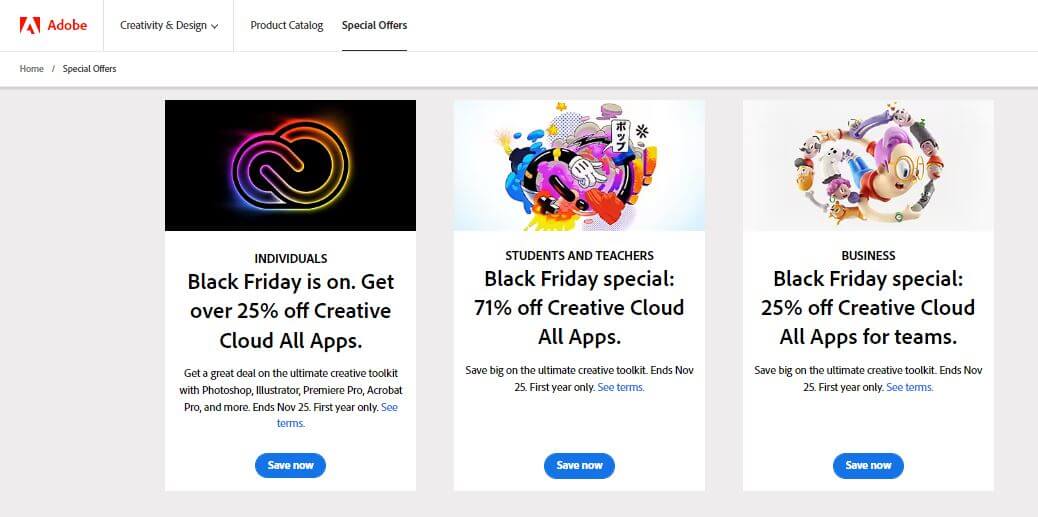
LinkedIn is also an important part of Adobe’s lead generation strategy. Its LinkedIn page is brimming with all kinds of content, including:
-
- Teaser posts that redirect users to its blog posts
-
- Videos
-
- Customer shoutouts
-
- Success stories
-
- Events
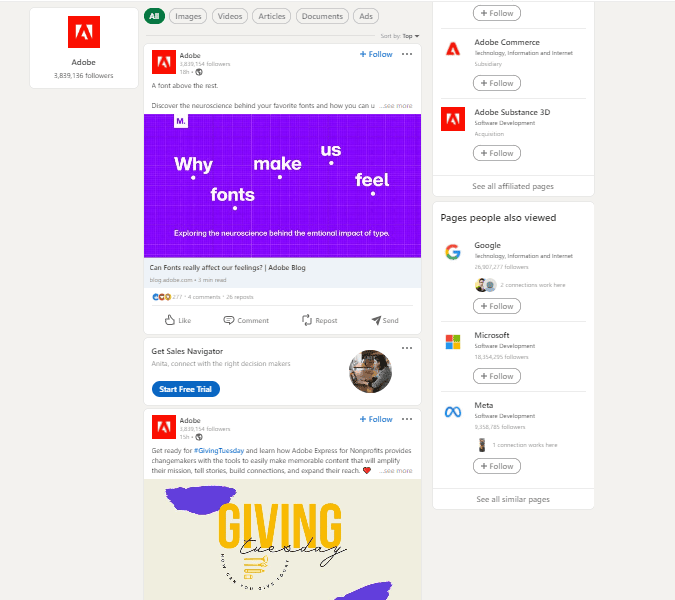
Takeaways from Adobe’s lead generation approach:
-
- Adobe has perfected the art of using special offers and free trials for effective lead generation.
-
- Adobe regularly publishes rich, versatile, and creative content on various social media platforms to reach and engage a range of leads.
Zoom Video Communications
Thanks to the pandemic and the need for social distancing, Zoom has become an essential part of many people’s everyday lives. COVID-19 helped Zoom grow fast, but it was more than just sheer luck that enabled Zoom to establish itself as a household name.
Zoom pays a lot of attention to its social media presence. And, unlike most other companies, Zoom was more than prepared to keep pace with hot new social media trends.
In addition to having Twitter, Instagram, and LinkedIn profiles, Zoom also joined TikTok. The entertaining, engaging, and casual content Zoom posts on this platform enabled it to reach a much younger target audience and create a specific brand identity that helps it stand out from the crowd.
Zoom is also huge on in-person and online events, which are regularly promoted on LinkedIn. Attendees can even register on LinkedIn directly.
The most important Zoom event is Zoomtopia — its annual user conference. There, Zoom announces its new products, features, and upcoming partnerships and elaborates on how Zoom can help connect and engage various users.
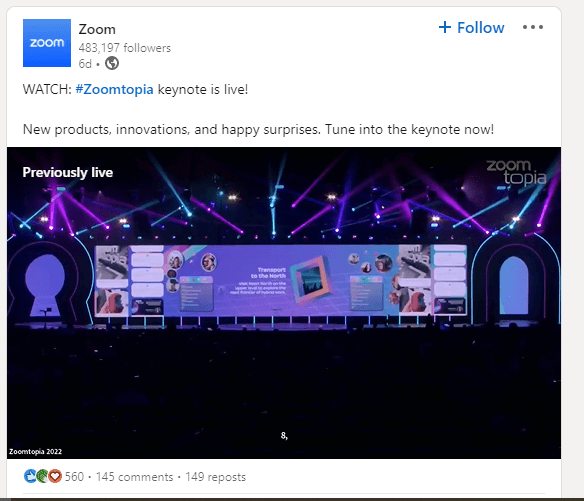
Another part of Zoom’s lead generation strategy is listening to its target audience. Zoom regularly posts polls on LinkedIn to gain insight into what its users want, need, or like/dislike the most about their experience with Zoom.
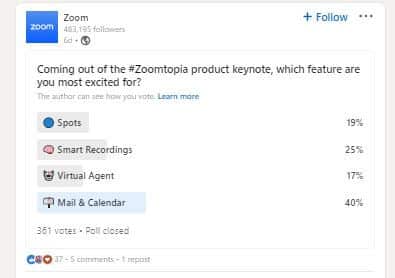
Another example of how seriously Zoom takes its customers’ opinions is that its team never fails to answer any and all questions asked on its social media pages.
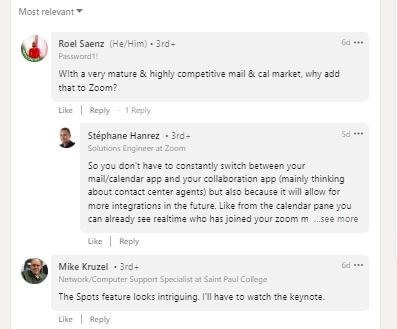
Takeaways from Zoom’s lead generation approach:
-
- Zoom puts a strong emphasis on its social media, tackling not only the platforms traditionally used by businesses like Twitter and LinkedIn but also TikTok — the ultimate new kid on the block.
-
- TikTok enabled Zoom to tap into a much wider pool of potential customers and position itself as a fun and friendly brand.
-
- Regularly answering all of its current and potential customers’ questions helps Zoom gain leads’ trust by showing they’ll always have all the support they may need.
-
- Its annual conferences and frequent smaller-scale events help engage and educate current and prospective customers alike.
LinkedIn as a lead generation strategy for Zoom
LinkedIn polls are yet another gold mine for high-quality leads. People who are interested enough to answer questions or fill out surveys that revolve around your product or service are very likely to be members of your ICP.
Scraping poll voters with Expandi can provide you with a list of leads quickly. Then, you can simply filter them by how they voted.
HubSpot
HubSpot is one of the leading companies in the sales and marketing industry.
As such, it heavily relies on content marketing. HubSpot publishes various types of content on several channels.
For example, in addition to having a blog on its website, HubSpot regularly publishes articles on platforms such as Medium, runs several podcasts, has a newsletter anyone can subscribe to, and tops it all off with a YouTube channel.

HubSpot also offers a number of free tools that give potential customers a taste of HubSpot before they opt for a premium plan.
In addition, there are plenty of free learning and training resources available, ranging from comprehensive guides to downloadable templates and eBooks.
HubSpot is extremely active on LinkedIn, too — its sales and marketing teams publish everything on this platform, including:
-
- Product and feature announcements
-
- Success stories
-
- Polls
-
- Webinars and events
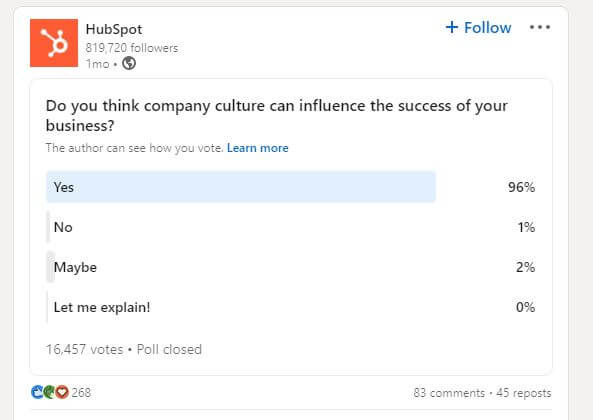
To further engage its current and potential customers, HubSpot asks various questions on LinkedIn as an effective way of starting conversations around its products.

Naturally, HubSpot always manages to stay on top of people’s minds.
Finally, many HubSpot products are listed on LinkedIn as skills that users can add to their LinkedIn profiles if they’re proficient in using them. Since HubSpot is a big name in marketing and CRM, this is a very attractive option for many prospective marketers and sales reps.

Takeaways from HubSpot’s lead generation approach:
-
- HubSpot’s marketing and sales teams primarily focus on two things regarding its lead generation process:
-
- Content marketing — As they create various types of content and publish it on several different marketing channels.
-
- LinkedIn outreach — They regularly post polls, publish success stories, ask and answer questions, promote events and webinars, etc.
-
- This enables HubSpot to reach and engage a vast number of people and establish itself as an industry expert. As a result, HubSpot easily attracts high-quality leads and gains their trust.
Tip: Creating LinkedIn skills people can add to their profiles immediately establishes your product as something worth having and mastering.
Slack Technologies
Slack is yet another company that boomed practically overnight. And it did all that without a huge sales team and a fancy marketing strategy.
So, how did Slack get to the top, then?
Right from the start, Slack counted on word-of-mouth marketing. Satisfied users spread the word about Slack’s awesomeness to their friends, family, and colleagues.
Thus, Slack got a heap of brand ambassadors without having to hire (and pay) any of them.
Furthermore, Slack made sure to listen to its customers. Regular surveys provided Slack with feedback which was regularly implemented in its product and feature updates.
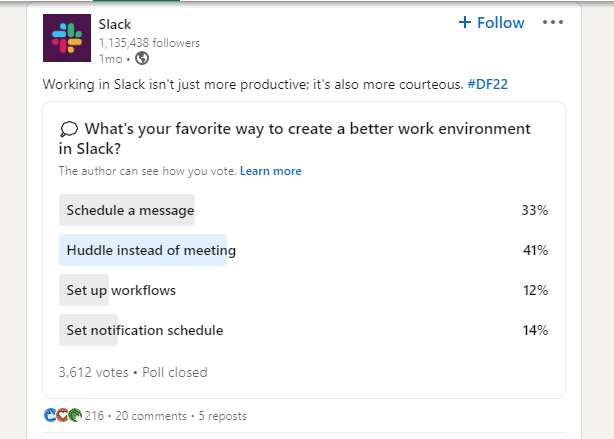
Finally, Slack took advantage of its numerous integrations, as it integrates with over 2400 apps. These integrations get Slack referral traffic and help it dominate the Search Engine Results Pages (SERPs) for terms like “Google Drive integrations”, “Gmail integrations”, and “Workday integrations”.
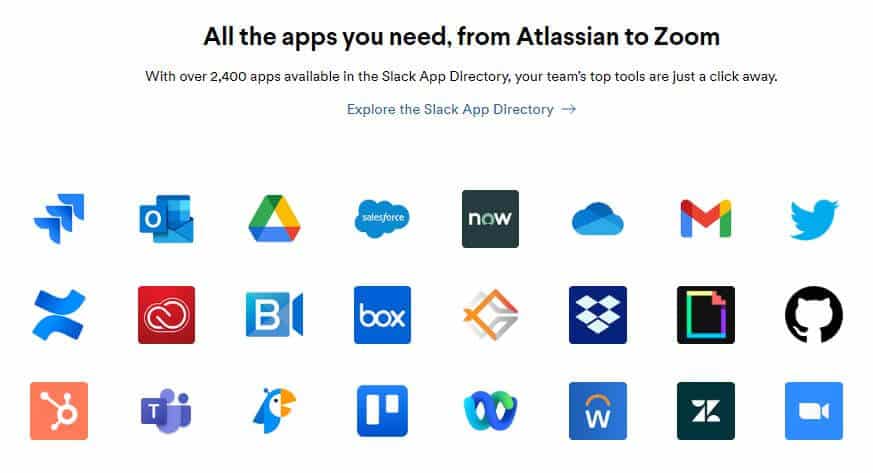
Of course, like other leading companies, Slack recognizes the importance of social media. That’s why it regularly posts on Twitter and LinkedIn, publishing everything from polls to events, feature announcements, videos, and short-form posts.
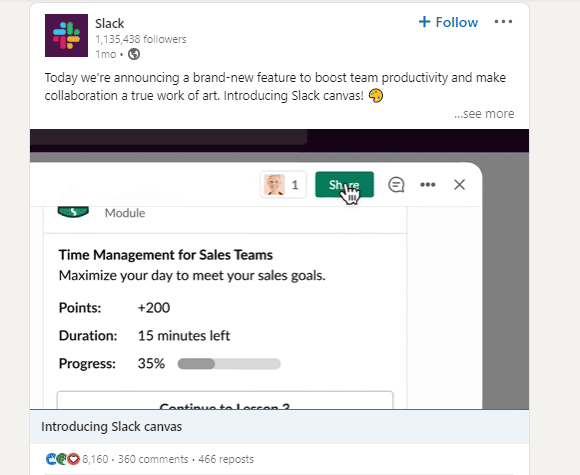
Takeaways from Slack’s lead generation approach:
-
- Slack relied on its satisfied customers’ willingness to spread the word from day one, and that strategy hasn’t failed so far.
-
- The clever use of integrations, coupled with the acute interest in its customers’ opinions and needs, also supercharged Slack’s lead generation processes.
-
- Regularly posting to Twitter and LinkedIn heavily contributed to Slack’s rapid growth and success.
Final thoughts: Designing a good lead generation process
If you’d like to be featured in a list of the world’s best companies one day — and honestly, who wouldn’t — you’ll need to develop a foolproof lead generation strategy first.
Of course, simple copy-pasting of other businesses’ frameworks and processes won’t yield results, no matter how successful these processes are.
However, there’s still a lot you can learn from the world’s finest lead generation strategies, including the following takeaways:
-
- Pinpoint your ICP and buyer persona first — Only then will you know who your target audience is and where to find them. Having a great understanding of your customers will help you create the perfect lead generation process for them.
- Have a multi-channel approach, and don’t restrict yourself to one method alone — Don’t be afraid to experiment and be innovative.
- Embrace content marketing — It’s one of your best friends when it comes to lead generation.
- Offer free resources — Leads won’t be able to resist them.
- Show leads that you value your customers — Answer their questions, listen to and implement feedback, provide educational materials, etc.
- Never underestimate the power of social media, especially LinkedIn — Make sure to regularly post engaging content such as articles, videos, and polls and promote everything from new features and product releases to events and webinars.
- Don’t shy away from using a lead generation tool — These tools can help you get more high-quality leads in less time.
One such tool that can help you perfect your lead generation strategy through a combination of LinkedIn and email automation is Expandi.
Expandi is a powerful cloud-based solution that:
-
- Has numerous cutting-edge functionalities
-
- Is perfectly safe to use
-
- Helps you send more connection requests than LinkedIn’s limit allows (and you won’t get banned!)
-
- Supports versatile use cases
As such, Expandi can get you a steady stream of high-quality leads in a matter of weeks.
Start your 7-day free trial right now and see how Expandi will transform your lead generation process in no time.
You’ve made it all the way down here, take the final step

